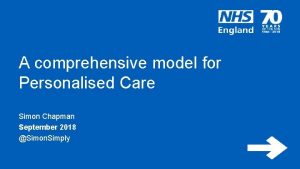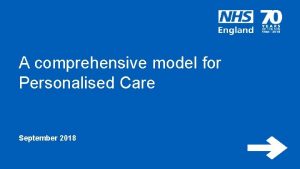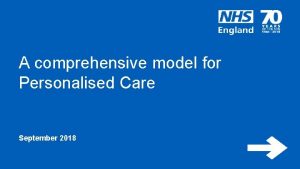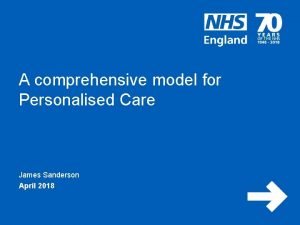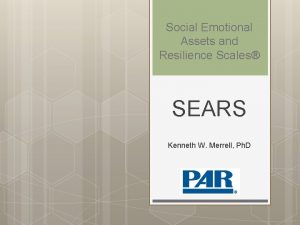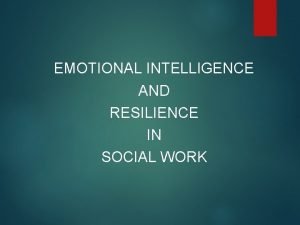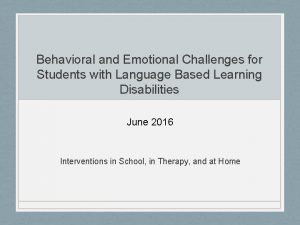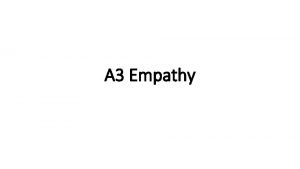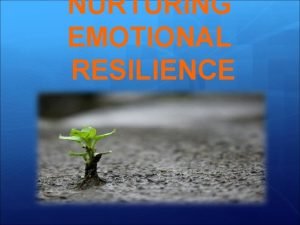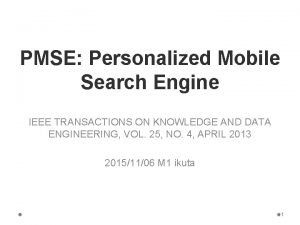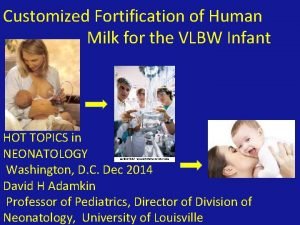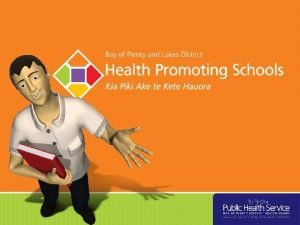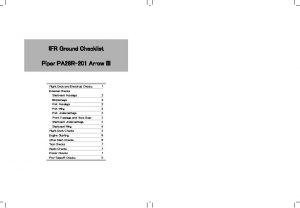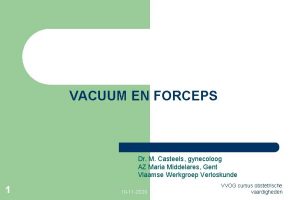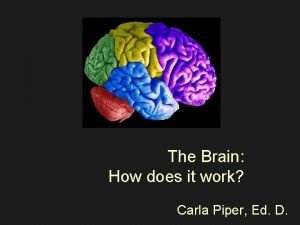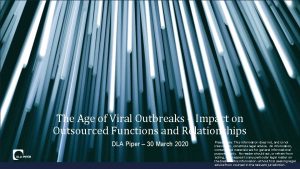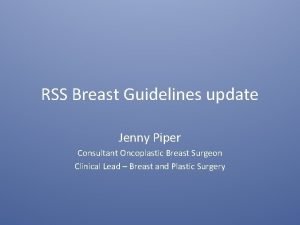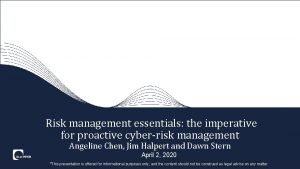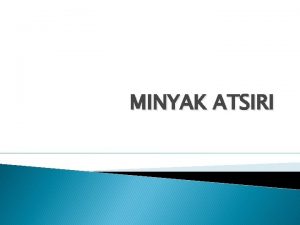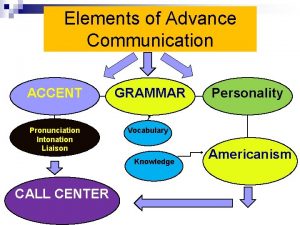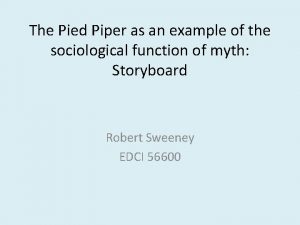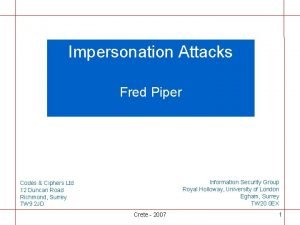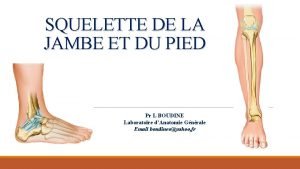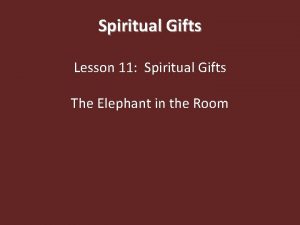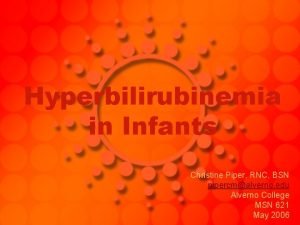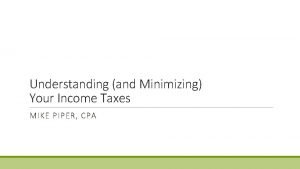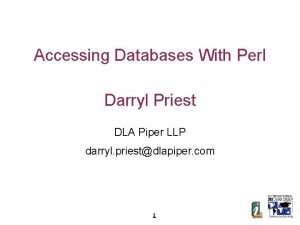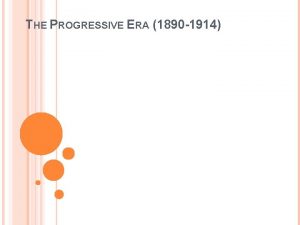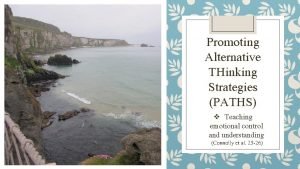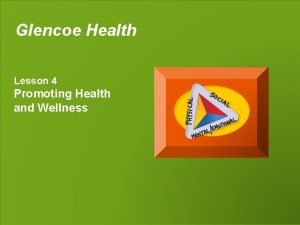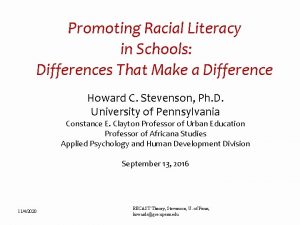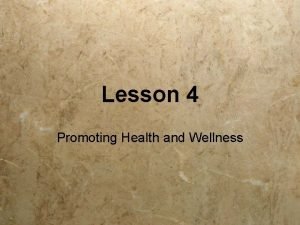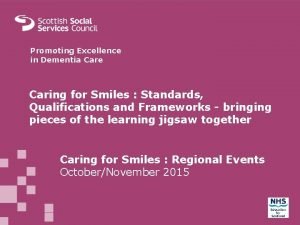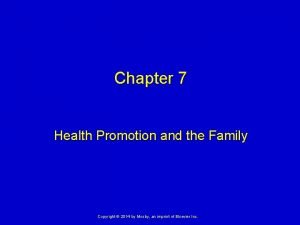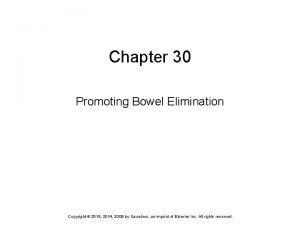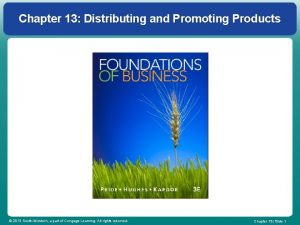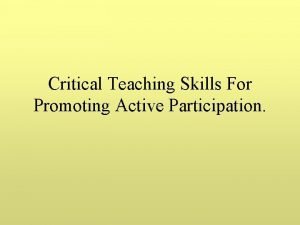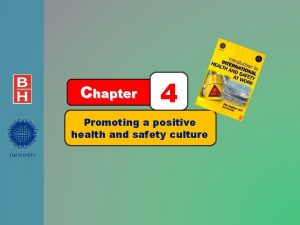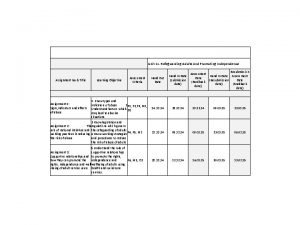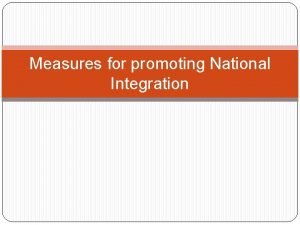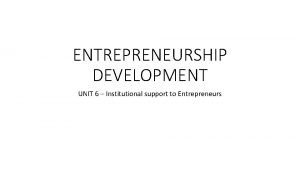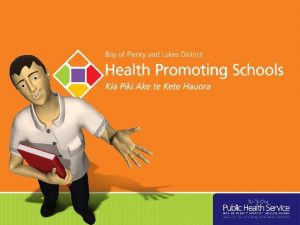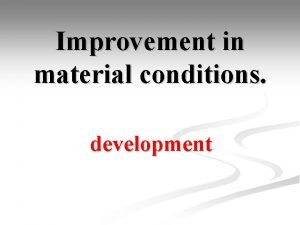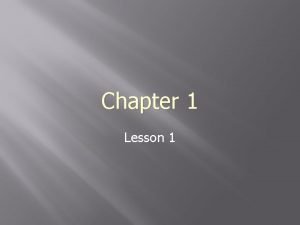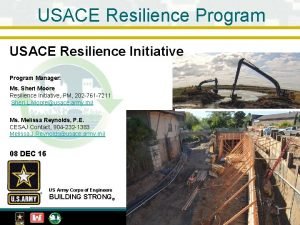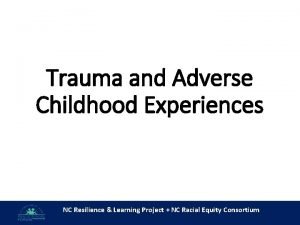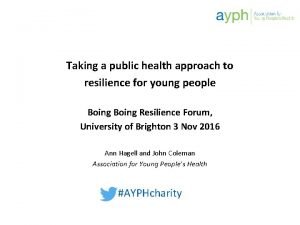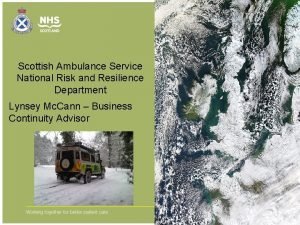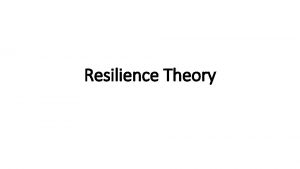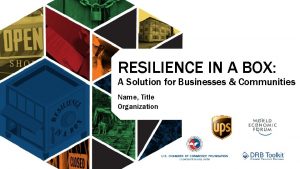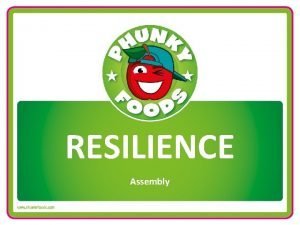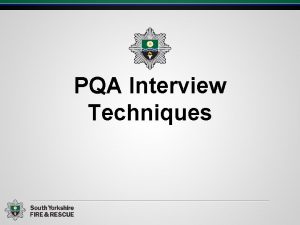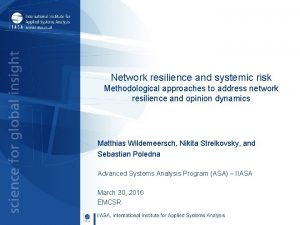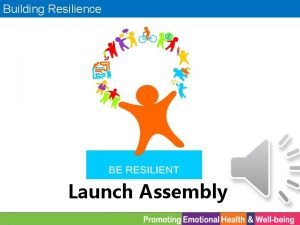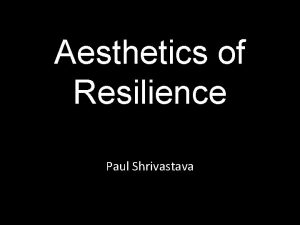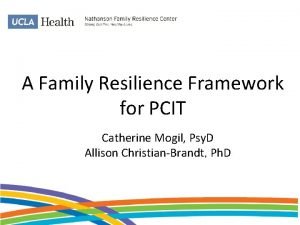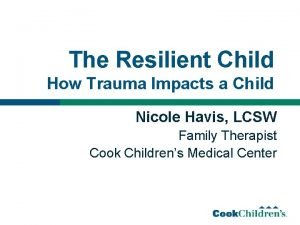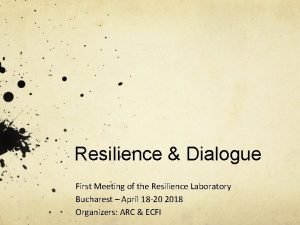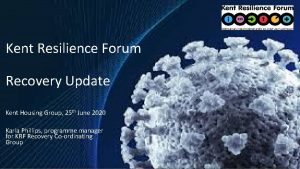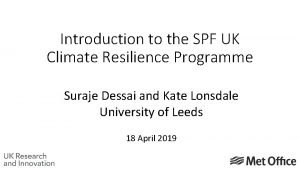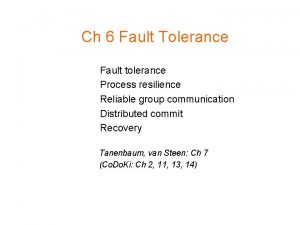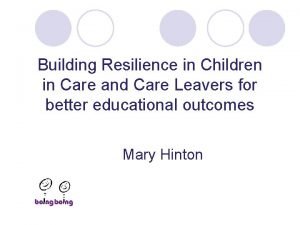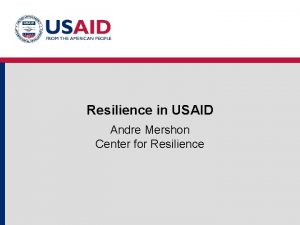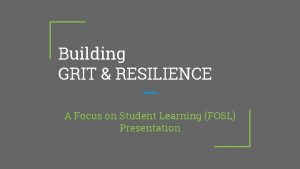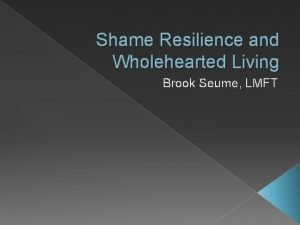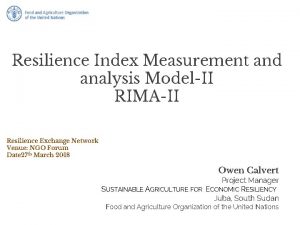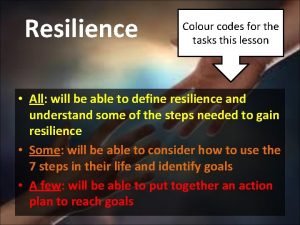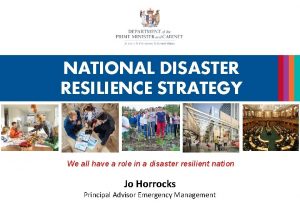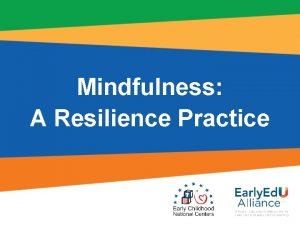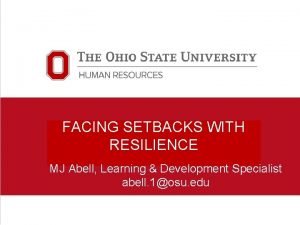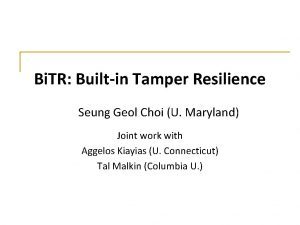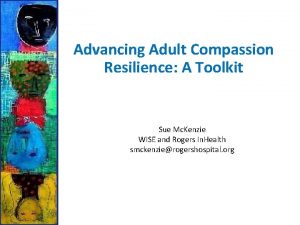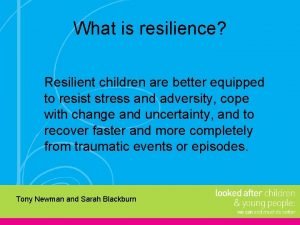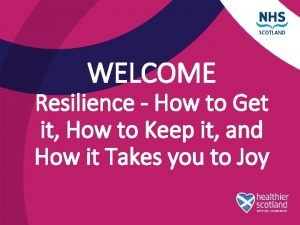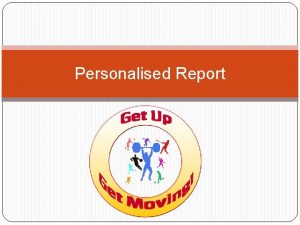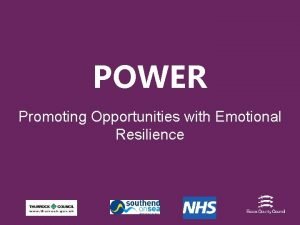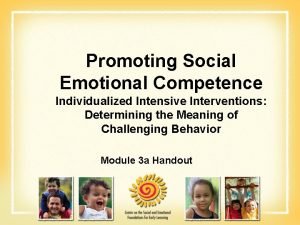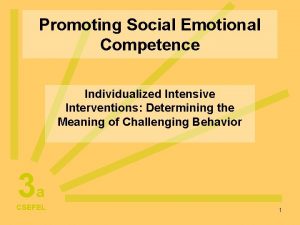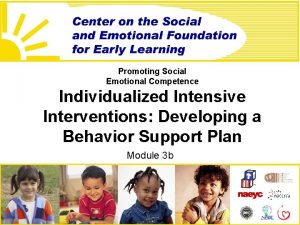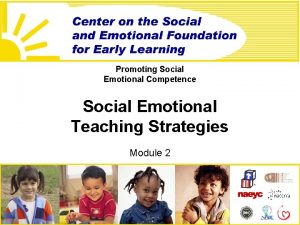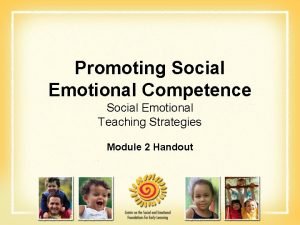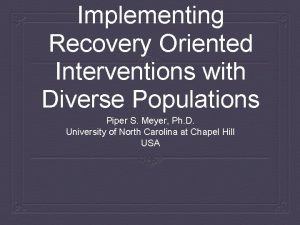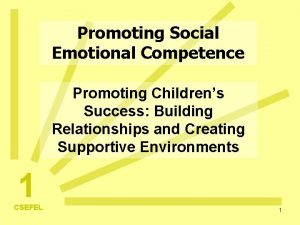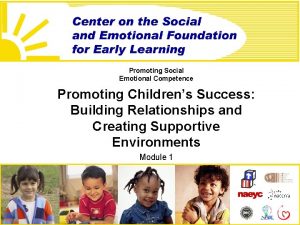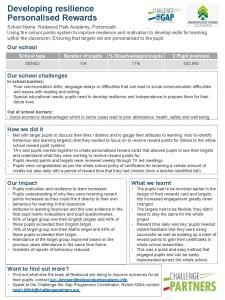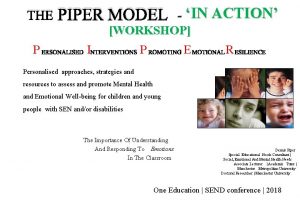The PIPER Model Personalised Interventions Promoting Emotional Resilience









































































![Pupil Profiling based on Risk and Resilience [Protective] Factors - using an interactive 4 Pupil Profiling based on Risk and Resilience [Protective] Factors - using an interactive 4](https://slidetodoc.com/presentation_image_h/ea6383904c2b9f2b0e2792a469cd7a25/image-74.jpg)

![EWB | Pupil Profiling based on Risk and Resilience [Protective] Factors - using an EWB | Pupil Profiling based on Risk and Resilience [Protective] Factors - using an](https://slidetodoc.com/presentation_image_h/ea6383904c2b9f2b0e2792a469cd7a25/image-76.jpg)



![© The [PIPER] “TENSION MODEL” - for recognising, predicting and responding appropriately to a © The [PIPER] “TENSION MODEL” - for recognising, predicting and responding appropriately to a](https://slidetodoc.com/presentation_image_h/ea6383904c2b9f2b0e2792a469cd7a25/image-80.jpg)
























- Slides: 104

The PIPER Model Personalised Interventions Promoting Emotional Resilience

A Relational approach to Positive Mental Health and Emotional Wellbeing for children and young people with Primary SEN/D Strategy National The Importance of understanding Anxiety, Applying Curiosity, Collaborative Working, Reflection, Self-awareness and Empathy when Managing our own Emotions and Responding to pupils’ behaviour © Crown Copyright 2005 SEND Conference ONE EDUCATION 23 rd March 2018 Dennis Piper Special Educational Needs Consultant Social, Emotional And Mental Health Needs Associate Lecturer | Academic Tutor Manchester Metropolitan University Doctoral Researcher | Manchester University dennis. piper@ntlworld. com

“First, Always Be Curious!” “ I hear what you’re saying … But what are you telling me? ” “___off!”

“Why are you kicking out at me Josh? Stop being so aggressive! I’m feeling hurt and stressed out!” “Please help me Miss! My life is a ____mess! I can’t cope! I’m feeling hurt and stressed out!” Nothing is Quite what it Seems …in the ‘World of SEMH’

Part One BESD SEMH The SEN/D Code of Practice 0 -25 (2015)

+ 3 years

Do you recognise any of these changes? v A single (joint) assessment & EHCP from 0 -25 years v Pupil & parents/carers are at the centre of all planning v BESD SEMH v Certain diagnosed behavioural conditions/disorders now designated as disabilities v Diagnosed behavioural disabilities can have personal budgets

…or these BESD to SEMH ‘shifts’? Policy shift: deficit holistic model Identify root causes of behaviour rather than symptoms i. e. the presenting behaviours Understand protective factors that lead to resilience Identify risk factors that influence children’s behaviour Early Intervention - using appropriate assessments Use interventions that build & promote resilience

The SEND Code of Practice (2015) defines SEMH difficulties using Medical Descriptors: Anxiety-related Disorders (e. g. GAD, Self-harm, Eating disorders, Panic Disorder, OCD, PTSD, Phobias, Selective Mutism, Stage Fright, Incident Stress + +) Mood-related Disorders (e. g. Depression, Bipolar Disorder) Conduct-related Problems (e. g. ODD, ADHD) Attachment-related Problems (e. g. RAD) Developmental-related Disorders (e. g. Autism, PDD) Addiction-related Problems (e. g. Substance Abuse) Psychotic Disorders (e. g. Schizophrenia) SEND Code of Practice 0 -25 years (Df. E, Do. H, 2015) page 97; Section 6: Schools, 6. 1 -6. 99, pages 91 -109

Definition of a person with a ‘disability’ under the Equality Act (2010) “Someone who has a physical or mental impairment that has a substantial and long-term adverse effect on his or her ability to carry out normal day-to-day activities. ” This includes many children labelled SEMH Mental health and behaviour in schools, Departmental advice for school staff, Department for Education, March 2015 para 1. 3 page 8

Process & Provision recommended by the SEND Co. P (2015) to address SEMH needs Also: how to manage the effect of any disruptive behaviour so it does not adversely affect other pupils 1. Pastoral Support - e. g. access to counselling 2. Details of evidence-based support - published in the school SEN policy 3. Staff Training - to understand the nature and extent of problems that require more specialist intervention including clear arrangements for making appropriate referrals to CAMHS SEND Code of Practice 0 -25 years (Df. E Do. H, 2015), pages 64 -65

(1) School Counselling (4) Clear referral routes to CAMHS Straw Poll (3) Staff SEMH Training (2) Evidenced Interventions

Are you ‘Child-focused’ or ‘Child-centred’? What is the difference? What is the difference © Crown copyright 2005

Why ‘Child-Centred’ is more effective for understanding ‘emotional wellbeing’ ü We start from children and young people’s ‘lived experience’ and look out from there ü We are able to ‘actively’ listen (with our eyes and ears) then reflect and act upon what we hear ü We build services around Children and Young People’s needs via ‘inclusive practice’ ü We understand behaviour as communication, remain curious about what is being communicated and do not jump to conclusions © Crown copyright 2005

Are you ‘Child-focused’ or ‘Child-centred’? Education Social Health Social Health Care Housing Care Housing ‘Child Focused’ ‘Child Centred’ “We know what you need” “What are you telling us you need? ” © Crown copyright 2005

Part Two Emotional Wellbeing M E N T A L Risk Factors H E A L T H Resilience Factors SEMH A new definition of ‘behaviour’ The impact of Risk & Resilience on Mental Health

So …What is ‘behaviour’ from a social emotional and mental health perspective?

A Rationale for Understanding Behaviour from an SEMH perspective v Behaviour is a manifestation of how we feel. How we feel is related manifestation to our level(s) of anxiety. So, behaviours are ‘anxiety-driven’. v Anxiety is related to our emotional wellbeing. Emotional wellbeing is a significant aspect of mental health v Child mental health involves ‘risk’ and ‘resilience’ factors interacting within 4 domains - individual, family, school and environment. v So, the primary focus for understanding behaviour should centre on ‘emotional wellbeing’ and ‘anxiety’ levels. ‘emotional wellbeing’ ‘anxiety’ Piper, D. (2017) The Piper Model, London and New York, Routledge, page 90

How does Risk and Resilience affect Mental Health and Emotional Wellbeing? Research evidence tell us that: Some individuals are more resilient than others Some children survive intact and develop into competent, confident and caring adults despite prolonged and negative experiences An important key to promoting children’s mental health is a greater understanding of those protective factors that enable these children to be resilient (MHF, 1999, p. 9) Emotional Maslow’s Hierarchy of Needs Risk Factors DECREASE Wellbeing M E N T A L H E A L T H Maslow’s Hierarchy of Needs Resilience Factors INCREASE

Risk Factors and Mental Health Ø Risk factors in children’s early years lead to increased risk of mental health problems in adolescence and adulthood Ø The greater the number and severity of risks the greater likelihood of the child developing a mental health problem Ø If a child has one risk factor in their life, their risk of developing a one mental health problem is 1 -2% Ø With three risk factors the likelihood increases to 8% three Ø With four or more risk factors the likelihood is increased to 20% Evidence suggests that children’s emotional wellbeing can be improved by reducing risk factors and increasing protective factors risk (MHF, 1999, p 7)

Severe sensory-deprivation neglect in early childhood - Neuroimaging CT scans © Crown copyright 2005

The neuroimages illustrate the negative impact of neglect on the developing brain. The CT scan on the left is from a healthy 3 -year-old child with an average head size (50 th percentile). The image on the right is from a series of three 3 -year-old children following severe sensory-deprivation neglect in early childhood. The child’s brain is childhood significantly smaller than average and has abnormal development of cortex (cortical atrophy) and other abnormalities suggesting abnormal development of the brain. Crucial areas of brain development in the first years of life, suggests why these years may be so predictive of future outcomes. A key finding is that babies are born with 25% of their brains developed, and there is then a rapid period of development so that 25% by the age of 3 their brains are 80% developed. In that period, neglect, the wrong type of parenting and other adverse experiences can have a profound effect on how parenting experiences profound children are emotionally ‘wired’. This will deeply influence their future responses to ‘wired’ events and their ability to empathise with / learn from other people. / learn ______________________________________________________________________ From studies conducted by researchers from the Child Trauma Academy (www. childtrauma. org) led by Bruce D Perry, MD, Ph. D. Perry BD (2002) Childhood experience and the expression of genetic potential: what childhood neglect tells us about nature and nurture. Brain and Mind, 3: 79– 100. © Crown copyright 2005

What should be Schools’ priorities? (1) Reduce risk and increase resilience factors via child-centred provision ‘quality first teaching’ delivered within optimal learning / therapeutic ‘settings’ (2) Produce better outcomes for children within the 5 ECM outcomes. (Df. E Green Paper, 2003; Children Act change for children, 2004; Help children achieve more , Df. E, 2010) (3) Demonstrate measurable academic progression. (Ofsted Inspection Framework, 2012) (4) Facilitate children and young people’s desired social, emotional and educational outcomes (Df. E, Do. H, SEN/D Code of Practice 0 -25, 2015) © Crown copyright 2005

Key ‘underpinning’ Theories that address Mental Health/Emotional Wellbeing of children Ø Child Development (Bowlby, 1969; Piaget, 1936, 1959; Vygotsky, 1962, 1978) Ø Hierarchy of Needs (Maslow, 1954) Ø Anxiety (Maslow, 1954; Seligman, 2011; Le. Doux, 2017) Ø Empathy (Gardner, 1993; Baron-Cohen, 2011) Ø Emotional Intelligence (Goleman, 1996) Ø Emotional Literacy (Faupel, 2003) Ø Organisational/Interactional Motivation

Part Three The Brain How Thoughts, Emotions, Speech Language & Communication impact on teaching, learning & behaviour

So…where does the Brain fit in? The Amygdala is responsible for the Amygdala expression of: Ø Fear and aggression Ø Defensive behaviour Ø The formation and retrieval of emotional and fear-related memories.

The Amygdala The section of the brain involved in learning about fear, danger and safety

Homer …


Thoughts, Emotions and The Brain © Crown copyright 2005

How feelings affect our thoughts Thinking How I interpret my feelings part of brain Emotional part of brain How I feel © Crown copyright 2005

Our Response To Threat Fight or Flight? THREAT © Crown copyright 2005

“He’s annoying me” Feeling Irritable © Crown copyright 2005

“He’s really getting on my nerves!” Feeling more irritable © Crown copyright 2005

“I know he hates me!” Interprets everything negatively © Crown copyright 2005

“I’ve had enough of him!” Overwhelmed by Emotions!! © Crown copyright 2005

Calming down ‘emotional rescue’ Therapeutic Techniques: üRelaxation üExercise üDistraction ü CBT ü Mindfulness © Crown copyright 2005

So … Thoughts, Feelings & Actions Influence Teaching, Learning & Behaviour

In turn … Self-reflection & Introspection Influence Thoughts, Feelings & Actions

As a consequence … Self-reflection & Introspection Influence Relationships & Interactions with pupils

Teaching & Reflecting on our own Emotions “Am I emotionally intelligent? ” Can you… 1. Label feelings 2. Recognise feelings 3. Acknowledge feelings 4. Manage feelings 5. Think about feelings 6. What you should do about them © Crown copyright 2005

The ‘Anger Mountain’ ~ also known as the ‘assault cycle’ Strength of Emotion/Anger/Tension/Anxiety TIME 3. CRISIS PHASE 2. ESCALATION PHASE 4. RECOVERY PHASE Possible additional assaults 5. DEPRESSION PHASE 1. TRIGGER PHASE BASELINE Be aware of body language; A Communication limited; C Stressed behaviour gives clues. T S Remove trigger I O Give alternative activity N Visual Reminder Exercise May need to: Give space Remove from room - may need to be quieter/darker Summon help Defuse Protect Safe place Safe person Go for a walk Child/Young person needs calm reassurance No blame Use Social Stories What to do when. . . Rehearsal of situations Agree visual reminders Where to go/who will help Teach strategies for relieving or controlling anxiety KEEP TALKING (UNLESS ASD) USING LANUAGE OF EMOTIONS IN A CALM SOOTHING TONE OF VOICE © Crown copyright 2005 KEEP CALM

How teacher self-reflection and introspection interface with thoughts, feelings and actions increasing self-awareness in the classroom.

C F I O D A U S F M K A F Emotions, Speech, Language, Communication and the Brain!! © Crown copyright 2005

Garrett’s Model of Speech Production How Emotional Wellbeing affects our ability to Communicate © Crown copyright 2005

So …what have we learned about ourselves when we look at Children’s Mental Health and Emotional Wellbeing “Thinking differently about a situation not only applies to helping the ‘vulnerable’ and ‘challenging’ individual but also to us as practitioners. ” “Behaviour cannot be fully understood or addressed holistically, without consciously ‘making the links’ between context (i. e. situation), thoughts (i. e. cognition), feelings (i. e. emotions) and response (i. e. actions). ” “We must learn to understand ourselves first in order to understand the ‘individual’ needs of others. ”

Part Four

What is Anxiety? Anxiety is an emotion an unpleasant feeling of tension accompanied by physical changes

Social Anxiety Panic Disorder with/without Agoraphobia Post Traumatic Stress Disorder Types of Anxiety Obsessive Compulsive Disorder Generalised Anxiety Specific phobia

Muscle Tension and/or Irritability Abdominal pain Dry mouth Sweating ANXIETY Rapid Heartbeat Physical signs Quick Shallow Breathing Difficulty Concentrating Nausea and/or Feeling faint Frequent urination or emptying of the bowels Fatigue and/or Disturbed sleep

Anxiety Checklist Do you Know your child? Be Curious… q Avoids group activities q Is a perfectionist q Obsessive self doubt q Overly concerned about performance and ability q Overly anxious about social behaviour and social success q Needs constant reassurance q Reluctant or refuses to attend school q Unable to relax q Very self-conscious q Dislikes attention q Difficulty speaking in group setting q Nervous habits: nail biting, hair pulling, foot or finger tapping, comforters, sucking clothes

Prevention of Anxiety in Children Primary prevention is the most effective method to decrease the incidence of anxiety and anxiety disorders (Clunn, 1991) Groups and education in substance abuse (and other anxiety-triggering behaviours in children and young people) Classes on anxiety and behaviour in children Increasing the child’s self esteem and confidence Primary Prevention Classes on Child development and growth Developing the child’s social skills Classes on parenting

What can we do? … …for those children whose anxietydriven behaviours precipitate some of the driven most challenging presenting behaviours? and disruptive

What do we need to look at behaviour from an Emotional Wellbeing perspective?

Empathy

What is Empathy? “Empathy is without question an important ability. It allows us to tune into how someone else is feeling, or what they might be thinking. Empathy allows us to understand the intentions of others, predict their behaviour, and experience an emotion triggered by their emotion. In short, empathy allows us to interact effectively in the social world. It is also the “glue” of the social world, drawing us to help others and stopping us from hurting others. ” Simon Baron-Cohen (2004) Professor of Psychology and Psychiatry Cambridge University © Crown copyright 2005

Haim G. Ginott (originally Ginzburg) (1922– 1973) was a school teacher, a child psychologist and psychotherapist and a parent educator. He pioneered techniques for conversing with children that are still taught today. © Crown copyright 2005

What ‘drives’ behaviour? “Why doesn’t HE ever think about how I feel? ” Teacher “Why is Mr X being so bad… he knows I’m upset!!!” Pupil with Autism

An event is the Cause of Concern: ‘observed behaviour’ “Nothing is quite what it seems!” Cause of Concern (examples): WHAT IS SEEN EVENT What’s happening? Spitting; Kicking out; Biting; Shouting out; Mute; Grabbing food; Screaming; Rocking; Licking objects. WHAT IS GENERALLY UNSEEN BIOLOGICAL FACTORS / INFLUENCES (ANY MEDICAL CONDITION/S OR DIAGNOSIS? ) _____________________________ SOCIAL, EMOTIONAL AND PSYCHOLOGICAL FACTORS / INFLUENCES (INCORRECT PATTERNING / MODELLING OF BEHAVIOUR) __________________________ “What is driving the behaviour? ” LEARNING ATTITUDES OPINIONS BELIEFS ENVIRONMENTAL FACTORS / INFLUENCES (SENSORY: V ISUAL / AURAL / PHYSICAL) VALUES The Ice B model is a ‘thinking tool’ designed to help an individual or a model ‘thinking tool’ group to discover the patterns of behaviour and factors / influences that behaviour Dennis Piper: Adapted from the Iceberg Model by E. Schopler (1994) underlie a particular event (or behaviour). underlie behaviour

The behaviours of children with mental health/emotional wellbeing needs behaviours can be wellbeing needs can analysed in the following way:

Make the ‘connection’? “I’m out of here…it’s my turn to speak next!” “Miss…I’ve got a tummy ache…I need to go to the toilet!” ‘High Anxiety’ ‘Irrational Thoughts’ ‘Panic Attacks’ ‘I Need To

I ‘made the connection’ …and DID something about it!!

Part Five the PIPER Model

Over 10 years I collaborated with teachers in 40+ schools to develop a child-centred and relational approach to child mental health. It viewed children’s behaviours as anxiety-driven and located in a series of mental health domains (or fields). mental health I called it the PIPER Model and wrote a book to help teachers become more introspective, reflective and to 'emotionally connect’ with those children more positively and empathetically.

What is the PIPER Model

the PIPER Model means: Personalised Interventions Promoting Emotional Resilience It is a ‘ 3 -step personalised, holistic intervention’ located in the field of Child Mental Health

PIPER Model - showing interlocking elements operational steps, overall change effect/action research framework and theoretical underpinnings. CHANGE PROCESS - PHASES AND CORE CAPACITIES FULLAN (1993) STRUCTURE: L 1 CHANGE PROCESS 3. DEVELOPMENT OF INCREASED 1. SHARED VISION 2. ORGANISATIONAL REPERTOIRES OF SKILLS STRUCTURES; NORMS; BUILDING / KNOW-HOW AMONG PRACTICES OF INQUIRY ORGANISATIONAL MEMBERS IMPLEMENTATION INITIATION Key: A = Action R = Reflect AGENCY: 1. VISION BUILDING IMPACT 4. COLLABORATION RISK? RESILIENCE ? 3. MASTERY ACTION RESEARCH STEP 1 A/R STEP 2 A/R STEP 3 A/R STEP 4 A/R CURRICULUM STEP 5 A/R INTERVENTIONS STEP 6 L 2 Using Cognitive Behavioural Theory to facilitate ‘mastery’ OPERATIONAL RISK AND RESILIENCE 4 -FIELD MAP 2017 L 3 EVIDENCE BASED RESEARCH/LITERATURE BIO-PSYCHOSOCIAL | MENTAL HEALTH | Ta. MHS | IAPT INDIVIDUAL/ FAMILY/ENVIRONMENT REDUCING ANXIETY MANAGEMNT PLAN (RAMP) WAVE (1) CONTEXT: CLASS A. MASLOW MID-BRAIN FIGHT-FREEZE FLIGHT STRESS / HIERARCHY ANXIETY LEVELS OF NEEDS 1954 ATTACHMENT THEORY PCT EMPATHY – H. GARDNER (1993) BARON-COHEN S. (2011): ZERO DEGREES OF EMPATHY E. I. -– GOLEMAN 1996 SLCN M. F. GARRETT (1975): MODEL OF SPEECH PRODUCTION (PSYCHOLINGUISTICS) EMOTIONAL LITERACY - FAUPEL A. 2003 RELATIONAL PEDAGOGY: Gergen; Buber; Pianta; Poulou; Freire; Aspelin MENTAL HEALTH / SEL RESEARCH: Ann Masten: Resilience 2001; 2014 Mandie Shean: Lit Review - resilience & young people 2015 Norman Garmezy: Children’s resilience to negative life events 1991 Michael Ungar: Resilience & child mental health in education settings 2005 Michael Rutter: Resilience (abuse and neglect) 1979; 2007; 2012; 2013 Emmy Werner: Resilience - longitudinal studies 1982; 1989 Katherine Weare: Mental Health in schools ENSEC 2011 Mark Greenberg: Promoting wellbeing in schools ENSEC 2011 Sarah Brennan: Integrated approach to mental health Young Minds 2011 Philip Slee: Outcome of evaluation of SEC initiative ENSEC 2011 Suzanne Denham: Social-emotionally competent pre-schoolers ENSEC 2011 Neil Humphrey: Social and Emotional Learning – a critical appraisal 2013 WAVE (2) CONTEXT: GROUP IMPLEMENT REVIEW EVALUATE WAVE (3) CONTEXT: ONE-TO-ONE ANALYSIS 3 -WAVE PROVISION MAP MULTI - LEVEL PROFILE EMOTIONAL wellbeing SCREENING & OBS TECHNIQUES INCLUSION GROUP DYNAMICS STAFF ‘MIND-SET SHIFT/ CHANGE? TENSION MODEL (ANXIETY STATES) CREATE A RISK AND RESILIENCE PROFILE BASELINE PROCESS RESEARCH METHODOLOGY ECM PATHS SEAL BOND OUTCOME CONTINUATION 2. INQUIRY 4. COLLABORATIVE WORK CULTURES QUALITY FIRST TEACHING C/Time Nurture Groups Pro-social Modelling RET CBT Fredrickson N. & Cline T. 2009: Conceptual Model of Provision Mapping Klaus Wedell / Exeter Model: Framework for Personalised Learning Planning Effective Provision: Audit Commission Guidance to Schools SEND Code of Practice (Df. E, Do. H, 2015) SAFE PERSON (RE. TRAUMA) / REWARDS 1. THERAPEUTIC STRATEGIES 2. BEHAVIOURISM/CONDITIONING / REINFORCEMENT DIAGNOSES / DESCRIPTORS ASD / ADHD / FAS / OCD ODD | DSM-6 CBT / RET / MINDFULNESS Functional Analysis System’s change (Fullan’s 4 -step model, 1993) / more inclusive schools ACTION RESEARCH: Stenhouse 1979 Lewin 1946 Carr and Kemmis 1990 John Elliot 1990 Jack Whitehead 1970 Jean Mc. Niff 1990 - Perspectives/methods investigated: Social Interactionism 1. Phenomenology – IPA 2. Mixed Methods – J. Creswell 1994 Transformative Design 3. Illuminative Evaluation Parlett, M. & Hamilton, D. 1972 4. Grounded Theory - Glaser B. and Strauss A. 1967 5. Systems Theory Berger P. and Luckman T. 1966: The Social Construction of Reality 6. . Real World Research: Robson, C. 2011 7. Case Study: Yin, R. 2003; 2013

Using the PIPER Model to guide you on the journey from ‘Practice-Based Evidence’ to ‘Evidence-based Practice’ Practice based evidence What is my current practice? Research Informed underpinnings What does the literature say about my current practice? Evidence based practice How can I use what I’ve learned from the literature to improve and reflect on my practice?

Profiling And Provision Mapping around ‘Risk And Resilience’ Using the PIPER Model as ‘Action Research’ 6 -Step EWB Action Research Model STEPS 1 AND 2: RISK AND RESILIENCE MODEL RISK AND RESILIENCE FRAMEWORK (MHF 1999) RISK AND RESILIENCE INTERACTIVE 4 -FIELD EWB MAP (PIPER, 2017) STAFF PROFILE CHILD / YOUNG PERSON USING R AND R FRAMEWORK STEPS 3 AND 4: ANXIETYDRIVEN BEHAVIOURAL PROFILING STAFF LOOK AT TENSION MODEL STAFF DEVISE PERSONALISED RAMP FOR CHILD / YOUNG PERSON STEP 5: 3 -WAVE PROVISION MAPPING STEP 6: MONITORING AND EVALUATIVE PROCESS STAFF LOOK AT SETTINGS CURRICULUM INTERVENTIONS WAVE 1: CLASS WAVE 2: GROUP WAVE 3: 1: 1 PERSONALISED IMPLEMENTATION REVIEW EVALUATION IMPACT MEASURES: CHILD / YOUNG PERSON IMPACT MEASURES: STAFF/SCHOOL SYSTEMS CHANGE

Using the PIPER Model in the ‘Assess, Plan, Do, Review’ process Step 1: Planning - including problem and situation analysis 1. Risk and Resilience Profiling using Mental Health Framework (1999) | 4 -field interactive EWB Map (Piper, 2017) 2. Creating a Reducing Anxiety Management Plan (RAMP) 3. Creating a personalised 3 wave Provision Map Step 4: Reflecting - on the on-going process of planning, acting and observing SENCo and staff evaluate the effectiveness of the RAMP and personalised 3 wave Provision Map at review using a strong evidence base. Has the action plan outcomes reduced the number of pupil risk factors and increased the number of resilience factors? Step 2: Action - implementing the plan Step 3: Observing - monitoring and evaluating the action Implement the RAMP and personalised 3 wave Provision Map. Use tally charts, diaries, pupil observation schedules, teacher feedback, pupil feedback. Action Research Cycle: Planning, Implementing, Monitoring, Reviewing and Evaluating for a Pupil with Mental Health/Emotional Wellbeing Needs.

Step 1: Risk and Resilience Profiling

Emotional Wellbeing: Profiling and Provision Mapping for Children and Young People Based On Risk and Resilience (Protective) Factors – A Process Model. Community/Environmental Protective factors Family Protective factors Wider support networks Community/Environmental Risk factors Family Risk factors Inconsistent or unclear discipline Affection Access to sport and leisure amenities At least one good parentchild relationship Individual Protective factors Gender (female) Good communication skills Supervision High standard of living Authoritative discipline Affection Support for education Schools with strong academic and non-academic opportunities Source: Mental Health Foundation (1999) Capacity to reflect Higher intelligence Religious faith Believing in control Humour Supportive parental relationship/absence of severe discord Good housing Parental conflict Individual Risk factors Hostile and rejecting relationships Difficult temperament Physical illness, especially if chronic and/or neurological Communication problems Academic failure Failure to adapt to a child’s changing needs Homelessness Physical, sexual and/or emotional abuse Learning difficulty or disability Specific developmental delay Low self-esteem Substance misuse Genetic influences Low IQ Death and loss, including loss of friendships Unemployment © Crown copyright 2005 Socioeconomic disadvantage Severe parental mental health problems Parental criminality or substance addiction Disaster Family breakdown Discrimination

From the original 3 -field Mental Health Framework (MHF, 1999) as part of my doctoral research, I developed an interactive 4 -field EWB Map (Piper, 2017). The new ‘field’ places a ‘spotlight’ on the ‘school’ as a ‘setting’ that can influence / impact significantly on children and young people’s mental health / emotional wellbeing.
![Pupil Profiling based on Risk and Resilience Protective Factors using an interactive 4 Pupil Profiling based on Risk and Resilience [Protective] Factors - using an interactive 4](https://slidetodoc.com/presentation_image_h/ea6383904c2b9f2b0e2792a469cd7a25/image-74.jpg)
Pupil Profiling based on Risk and Resilience [Protective] Factors - using an interactive 4 -field EWB Map Community and Environment: Resilience [Protective] Factors Wider family or extended support networks [ ] Access to sport and leisure amenities [ ] Good overall standard of living [ ] Schools with strong academic and nonacademic opportunities [ ] School: Resilience [Protective] Factors Clear policies on behaviour and bullying [ ] Community and Environment: Risk Factors School: Risk Factors Radicalisation [ ] Bullying [ ] Supportive parental Family: Resilience relationship/absence of [Protective] Factors obvious disharmony [ ] At least one good parent child relationship (or one supportive adult) [ ] ‘Open-door’ policy for children / parents/staff to raise problems [ ] An evidenced whole school approach to promoting good pupil mental health / emotional wellbeing [ ] Individual: Resilience [Protective] Factors Being female (in younger children) [ ] Good communication skills/sociability [ ] Belief in self-control [ ] Evidenced Affection [ ] Positive Supervision [ ] Positive, clear and consistent discipline [ ] A whole school approach to addressing and promoting positive staff mental health / emotional wellbeing [ ] Support for education [ ] A sense of belonging [ ] Positive Peer influences [ ] Humour [ ] A positive attitude [ ] Faith or spirituality [ ] Problem solving skills [ ] Experiences of success and achievement [ ] Secure attachment experience [ ] Capacity to reflect [ ] Higher (measured) IQ [ ] Outgoing temperament as an infant [ ] Multi-generational Supportive family [ ] Positive classroom management / interactions [ ] Good teacher-pupil relationships [ ] Good housing / accommodation facilities [ ] Parental criminality/ Family: substance addiction/ Risk personality disorder [ ] Factors Overt parental conflict including Domestic Violence [ ] Individual: Risk Factors Learning difficulty or disability [ ] Academic failure [ ] Over- Sexualised behaviour [ ] Low self-esteem [ ] Specific developmental delay [ ] Communication problems [ ] Genetic influences [ ] Low (measured) IQ [ ] Difficult temperament [ ] Physical illness, especially if chronic and/or neurological [ ] Radicalised behaviour [ ] Substance misuse [ ] Multigenerational Conflicted family [ ] Prejudice and/or Discrimination [ ] Radicalisation [ ] Family breakdown including adoption / in care [ ] Female Genital Mutilation [ ] Parental debt [ ] Inconsistent or unclear discipline [ ] Failure to adapt to a child’s changing needs [ ] Hostile and rejecting Physical, Sexual relationships [ ] or Emotional Abuse [ ] Long-term unemployment [ ] Severe Death and loss, parental including loss of mental health problems [ ] friendships [ ] Poor classroom management / interactions [ ] Poor teacher-pupil relationships [ ] Unemployment [ ] Lack of an evidenced whole school approach to promoting good pupil mental health / emotional wellbeing [ ] Lack of an evidenced whole school approach to promoting positive staff mental health / emotional wellbeing [ ] Breakdown in or lack of positive friendships [ ] A sense of isolation [ ] Deviant Peer influences [ ] Negative Peer pressure [ ] Poverty [ ] Concerns about Sexual Exploitation [ ] Evidenced Community Conflict or breakdown in relations [ ] Social isolation or exclusion [ ] Homelessne [ ] Radicalisatio [ ] Disaster [ ] Experience of Prejudice and / or Discriminati [ ] Female Genital Mutilation [ ]

Risk and Resilience Profiling - An example -
![EWB Pupil Profiling based on Risk and Resilience Protective Factors using an EWB | Pupil Profiling based on Risk and Resilience [Protective] Factors - using an](https://slidetodoc.com/presentation_image_h/ea6383904c2b9f2b0e2792a469cd7a25/image-76.jpg)
EWB | Pupil Profiling based on Risk and Resilience [Protective] Factors - using an interactive 4 -field EWB Map Community and Environment: Resilience [Protective] Factors Wider family or extended support networks [ ] Access to sport and leisure amenities [ ] Good overall standard of living [ ] Schools with strong academic and nonacademic opportunitie s [ ] School: Resilience [Protective] Factors Clear policies on behaviour and bullying [ ] Community and Environment: Risk Factors Radicalisation [ ] School: Risk Factors Bullying [ ] Supportive parental Family: Resilience relationship/absence of [Protective] Factors obvious disharmony [ ] ‘Open-door’ policy for children / parents/staff to raise problems [ ] At least one good parent child relationship (or one supportive adult) [ ] Evidenced Affection [ ] An evidenced whole school approach to promoting good pupil mental health / emotional wellbeing [ ] Positive Supervision [ ] Positive, clear and consistent discipline [ ] A whole school approach to addressing and promoting positive staff mental health / emotional wellbeing [ ] Support for education [ ] A sense of belonging [ ] Positive Peer influences [ ] Individual: Resilience [Protective] Factors Being female (in younger children) [ ] Good communication skills/sociability [ ] Belief in self-control [ ] Humour [ ] A positive attitude [ ] Faith or spirituality [ ] Family: Parental criminality/ substance addiction/ Risk personality disorder [ ] Factors Individual: Risk Factors Learning difficulty or disability [ ] Academic failure [ ] Over- Sexualised behaviour [ ] Low self-esteem [ ] Specific developmental delay [ ] Communication problems [ ] Genetic influences [ ] Problem solving skills [ ] Low (measured) IQ [ ] Experiences of success and achievement [ ] Difficult temperament [ ] Secure attachment experience [ ] Capacity to reflect [ ] Higher (measured) IQ [ ] Outgoing temperament as an infant [ ] Multi-generational Supportive family [ ] Positive classroom management / interactions [ ] Good teacher-pupil relationships [ ] Good housing / accommodation facilities [ ] Prejudice and/or Discrimination [ ] Radicalisation [ ] Overt parental conflict including Domestic Violence [ ] Family breakdown including adoption / in care [ ] Parental debt [ ] Inconsistent or unclear discipline [] Hostile and rejecting relationships [ ] Failure to adapt to a child’s changing needs [ ] Physical illness, especially if chronic and/or neurological [ ] Physical, Sexual or Emotional Abuse [ ] Radicalised behaviour [ ] Long-term unemployment [ ] Substance misuse [ ] Multigenerational Conflicted family [ ] Death and loss, including loss of friendships [ ] Severe parental mental health problems [ ] Female Genital Mutilation [ ] Poor classroom management / interactions [ ] Poor teacher-pupil relationships [ ] Unemployment [ ] Lack of an evidenced whole school approach to promoting good pupil mental health / emotional wellbeing [ ] Lack of an evidenced whole school approach to promoting positive staff mental health / emotional wellbeing [ ] Breakdown in or lack of positive friendships [ ] A sense of isolation [ ] Deviant Peer influences [ ] Negative Peer pressure [ ] Poverty [ ] Concerns about Sexual Exploitatio n [ ] Evidenced Community Conflict or breakdown in relations [ ] Social isolation or exclusion [ ] Homelessness [ ] Radicalisatio [ ] Disaster [ ] Experience of Prejudice and / or Discriminatio [ ] Female Genital Mutilation [ ]

EWB | ‘Risk and Resilience (Protective) Factors’ Pupil Profiling SCHOOL: ____________________________ Pupil’s first name: ___________ M [ ] F [ ] Year: ____ Activity: Using the Risk and Protective Factors Interactive 4 -field EWB Map, please complete the proformas below. A) RESILIENCE ENHANCING (1) Identified ‘Protective’ (Resilience) Factor/s (use diagram): (2) Observable Characteristics and Behaviour/s within School and the Classroom e. g. on-task, interaction with peers/staff, social, interpersonal and communication skills: (3) Skills, Strategies, Ideas or Plans to acknowledge, reinforce and promote these strengths: B) RISK REDUCING (1) Identified ‘Risk’ Factor/s (use diagram): (2) Observable Characteristics and Behaviour/s within School and the Classroom e. g. on/off task, interaction with peers/staff, social, interpersonal and communication skills: (3) Skills, Strategies, Ideas or Plans required to address identified concern/s or ‘risk/s’:

Risk and Resilience Profile for Anna - a ‘worked’ example Identified Risk Factor(s) Identified Protective Factor(s) Skill, Strategies, Ideas or Plans required to address identified concern(s) or risk(s) Observable Characteristics and Behaviour(s) 1. Gender - female 1. Communication 2. Good communication 2. Low self esteem verbalise why/what’s morning/LM at lunchtime; lots of 3. Capacity to reflect 3. Academic failure happened reinforcement of what she can do; 4. Affection 4. Genetic influences Will say. . . ‘I can’t do this’, ‘I giving her responsibility; picking 5. Access to leisure 5. Difficult temperament can’t read’ her out of the group; praising 6. Schools with strong academic and 6. Inconsistent/unclear Not made expected progress what she does non-academic opportunities discipline academically – moved down 2. Extra time with KK/JWi/LM - to Hostile and rejecting a group complete FA; 1: 1 support at 7. relationships 8. Failure to adapt to child’s changing needs 9. Emotional abuse 10. Severe parental mental 1. 2. 3. Disadvantaged area 12. Discrimination 13. Unemployment 1. 4/10. Mum’s OCD 1. Brother – statement for BESD 2. for 15 3. Mum – under table, count to 10, tells what has been said, drags Anna across playground 4. Mum – noticed in the morning before school 5. In morning – unable to come to school later – blames on her own OCD 6. Witnessed in the playground in the morning Remove Anna from a situation before she becomes distressed; Kicks, throws, pushes, punches, head-butts Time with KK in the lunchtime; 30 minutes outside, in distract her; take her out of the scratches, bites, screams, health problems 11. Becomes very cross, can’t playground 4. Chill out room in the morning 5. Speak to Mum out of earshot of Anna.

Step 2: Tension Model and Reducing Anxiety Management Plan (RAMP)
![The PIPER TENSION MODEL for recognising predicting and responding appropriately to a © The [PIPER] “TENSION MODEL” - for recognising, predicting and responding appropriately to a](https://slidetodoc.com/presentation_image_h/ea6383904c2b9f2b0e2792a469cd7a25/image-80.jpg)
© The [PIPER] “TENSION MODEL” - for recognising, predicting and responding appropriately to a pupil’s emotional levels and presenting (i. e. observable) behavioural difficulties. UP ATTACKING STATE Pupil Behaviour: Loss of self-control with a need to attack something or someone i. e. frenzied. Has a great deal of strength/energy to expend – very difficult to talk to/manage. UP DOWN AGGRESSIVE STATE Pupil Behaviour: Extremely tense, confrontational and irrational (severe physically challenging actions). AGITATED STATE UP Pupil Behaviour: Increasing tension and physically unsettled. Clearly challenging staff authority and/or control e. g. jumping on chair/throwing things/banging window/ shouting loudly. THRESHOLD BETWEEN RATIONAL AND IRRATIONAL BEHAVIOUR DOWN UP Staff Response: To prevent injury or harm to the person themselves; to prevent injury or harm to other people-appropriate physical restraint; to remove from premises with support – inter-agency meeting (follow up). Staff Response: To use non-verbal signals (non provocative body posture). Physical proximity to pupil is crucial i. e. safe distance if pupil ‘hits out’ (2 staff minimum present); to try and ‘let the fire burn out’ without increasing pupil tension; to encourage pupil to adopt slow breathing actions (speaking in a calm, clear voice); to move other pupils to a ‘safe’ place – quickly/calmly/orderly (2 staff to supervise); to increase language (verbal strategies) during ‘lulls’ and as the pupil calms to Agitated/Anxious states. Staff Response: To prevent other pupils being interfered with/provoked – move other pupils to a ‘safe’ place (if necessary) and in orderly fashion; to deploy 1 member of staff for observation/physical and emotional support; to deploy 1 member of staff for talking to pupil – “please do it for me” (personalise); to clearly remind pupil of rules/behavioural boundaries – calmly and clearly; to avoid being further provoked – remain calm. Think before saying/doing anything; to stand in a relaxed manner but not too near pupil – proximity to pupil is crucial!; to allow pupil to make a choice or face the consequences – ‘self-management’; to allow pupil time to follow instructions, if possible – ‘time out’ facility available; to ensure that consequences can be enforced – are they pragmatic/relevant/realistic? ; to allow pupil to ‘save face’ – if they do it and swear the outcome has still been achieved (specific praise for ‘positives’ and ignore ‘negatives’ if possible. ANXIOUS STATE Pupil Behaviour: Beginning to feel uncomfortable and tense. Avoiding contact, fussing more than usual, sitting away form others and difficulty in concentration/remaining ‘on task’. DOWN UP Baseline To reassure pupil that they can be supported - “we do care about you”; to suggest talking about problem - “we can try to make things better”; to tell pupil that you are aware they are unhappy (stay near if pupil doesn’t respond); to reassure pupil that you are available if they wish to talk – ‘library area’ available. Staff Response: CONTROLLED STATE Pupil Behaviour: Generally calm/compliant but can be ‘giddy’ or ‘boisterous at times. DOWN Staff Response: © Crown copyright 2005 To harness, maintain and develop pupil’s positive attitude to staff/others/work; to give specific and general praise regularly (celebrate achievements) – ‘circle time’; to remind pupil (if behaving ‘silly) of rules/boundaries in a clear and calm manner.

** At Home means child is with biological parents / step parents / adoptive parents (under section 3 of the 1989 Act, being all the rights, duties, powers responsibilities and authority which by law ‘parental responsibility’ has in relation to the child and his property). ** Relative(s) means person(s) ‘connected with’ the child in question / if that same child is ‘looked after’ (under section 105 of the Children Act 1989). Note: A “looked after child” / “child in public care” means a person under 18 who is subject to a care order under section 31 of the Children Act 1989 (including an interim care order), or is accommodated under section 20 of that Act. A “foster carer” means a person who is approved as a local authority foster parent (by a local authority or an independent fostering provider) in accordance with regulation 27 of the Fostering Services (England) Regulations 2011, or temporarily approved under regulation 24 of the 2010 Regulations.

LEVEL(5): ATTACKING / DISTRESSED STATE PUPIL BEHAVIOUR: LEVEL (4): AGGRESSIVE / HIGHLY STRESSED STATE PUPIL BEHAVIOUR: LEVEL (3): AGITATED STATE (Threshold between Rational / Irrational Behaviour) Reducing Anxiety Management Plan: School: ______ Pupil: _____ Year: ___ Date: _______ PUPIL BEHAVIOUR: PUPIL SELF-CALMING STRATEGIES: STAFF STRATEGIES: PUPIL BEHAVIOUR: PUPIL SELF-CALMING STRATEGIES: STAFF STRATEGIES: LEVEL (2): ANXIOUS STATE Ba Base LEVEL (1): CONTROLLED STATE seline PUPIL BEHAVIOUR: PUPIL SELF-CALMING STRATEGIES: STAFF STRATEGIES: Context Codes: Class (C) Playground (P) Dinner time (D) Transport (T)

A Reducing Anxiety Management Plan (RAMP) for Anna – a ‘worked’ example Level 5 - ATTACKING STATE PUPIL BEHAVIOUR STAFF STRATEGIES Deliberately kicks/throws Leave in chill out room on own (1 minute) Throws in direction of staff members Adult to go in when it is safe to do so Reassure Anna that you are not going to leave (repeat it several times – firmly say ‘I am not going to leave but you can’t throw something at me I will have to because it’s not safe’ Try to distract with a book or toy Level 4 - AGGRESSIVE STATE PUPIL BEHAVIOUR STAFF STRATEGIES Kicking/throwing chairs 2 adults to remove Anna from the environment to the chill out room Emptying/throwing boxes of toys State firmly that. . . ’you do not throw at me. . . you can throw things if you want to but you Starts throwing toys near adults Goes under tables – kicks them repeatedly do not throw at me. I will have to leave as I won’t be safe Give options – you can do this or this If adult attempts to leave she may hold onto legs – distract, I don’t mind you doing that but it’s hurting my back, I’ll sit down and you can hold them. . . I need the toilet, I need a drink of water - ALWAYS reassure that you will return Threshold (rational/irrational) Level 3 - AGITATED STATE Threshold (rational/irrational) PUPIL BEHAVIOUR STAFF STRATEGIES Runs out of playground/classroom Take Anna to the chill out room/library Takes coat off 1 adult to stay in the chill out room with Iris Kicks/pushes a chair (once or twice) Pushes a crate (once or twice) Goes and sits under a table Body Language/expression - cross face, pouts lips, folds arms Distract Anna - message or to do a job – walk down junior corridor, to staff room Level 2 - ANXIOUS STATE PUPIL BEHAVIOUR STAFF STRATEGIES Wriggly Heightened awareness Lacks in concentration Inform other members of staff Remind Anna of what to do if something happens Level 1 - CONTROLLED STATE Baseline STAFF STRATEGIES PUPIL BEHAVIOUR Baseline No evidence at this point in time

Step 3 Provision Mapping

Provision Mapping for SEMH - The 3 ‘waves’ model Additional highly Wave 3 personalised Interventions e. g. 1: 1 support Wave 2 Small-group interventions for children/students who need additional help in developing skills, mental health Self-help strategies and for their families Wave 1 Quality first teaching of social, emotional and behavioural skills to all children; an effective and positive ‘wholeschool’ wellbeing ethos or ‘educational setting’; policies, good practice and ‘learning frameworks’ for promoting positive mental health / emotional wellbeing. © Crown copyright 2005

© the PIPER Model 3 -Wave Provision Map SCHOOL: _____________________________________________________________ NAME: _____________________ YEAR: ______ REVIEW DATE: ________________ CURRICULUM INTERVENTIONS WAVE [1] [2] [3] (SETTINGS) (CURRICULUM) (INTERVENTIONS) START DATE: __________ RISK ASSESSMENTS AND PREVENTIVE MEASURES (REFER TO REDUCING ANXIETY MANAGEMENT PLAN) RISK FACTORS RESPONSE REWARD (HEALTH AND SAFETY) (PREVENTIVE STRATEGIES) © Crown copyright 2005 (POSITIVE REINFORCEMENT) IMPACT SUCCESS CRITERIA (MEASURABLE OUTCOMES)

Anna | Provision Mapping: Wave 1 - Whole Class Settings (a worked example) SITUATION/ SETTING Wave 1 Whole Class/school situations PSRN/CLL Carpet Time/ Registration Continuous Provision RISK ASSESSMENT AND PREVENTATIVE MEASURES Risk Factors (Health and Safety) Pre-anxiety Level Bored/inattentive Uninterested in topic being covered Become fidgety Anxiety Level Unstructured – doesn’t always get Tidy-up Time Response (Preventative Strategies) own way Level of tolerance for peers Inability to share Another child becoming injured – through her frustration Anxiety level Not having finished her work/game Other children saying ‘it is tidy up time’ Another child becoming injured through her frustration Dinner Time/ Play Time PE. Assembly/Singing Practice Anxiety Level Weather – coat on/off Level of tolerance for peers Inability to share Another child becoming injured – This is an area of strength for her Another child becoming injured – through her frustration Pre-anxiety level Bored/Inattentive Pre-anxiety Level Fidgety Ask to go to toilet Ensure there is a visual stimulus If becoming distracted give a job to do, send to a TA to help etc. Allow her to move without asking if needed Sit her next to a good role model/friend Lots of positive reinforcement Provide suitable adult support if needed Distract – take out of the situation/classroom if is becoming more anxious Say HT/Site manager is looking forward to seeing her later when she has had a fabulous day Modelling play – adult to manage children around her so not too many if she is anxious Give a five minute warning Allow her to leave her unfinished work in a safe place Allow her a little time to start tidying up – adult is not to constantly remind her Ensure an adult is nearby to direct the children around her Do not direct her to tidy something – she will normally choose something herself Give positive feedback to other children for their hard work 1: 1 support during lunch time/ play time Have 1: 1 in classroom before tidy up time starts If becoming anxious distract – take her out of Allow her to choose inside with an adult if she wants – calmer/quieter there Ensure adult is supervising at all times Monitor level of anxiety – distract if needed IMPACT Reward (Positive Reinforcement) Success Criteria (Measurable Outcome) Verbal praise Thumbs up Stickers Opportunity to help/become the V. I. P I can stay participate in CT/Registration (at least 10 x p/wk. ) Verbal Praise Stickers Visit to the HT Visit site manager at end of the day I can play in my classroom without becoming aggressive (at least 10 x p/wk. ) Lots of verbal praise Stickers Visit to HT Visit to the site manager Using her as a sample of excellence to her peers I can help at tidy up time (at least 10 x p/wk. ) Verbal praise Stickers Visit to the HT Visit to the site manager Make fairies Allow her to demonstrate to her peers Verbal praise Stickers Praise Stickers I can play out without becoming aggressive (at least 10 x p/wk. ) To remain in the classroom and not go into assembly unless getting a certificate/class assembly with lots of visual stimulus Sit on end of row near adult Allow to go to the toilet when asks I participate in PE. (80% of the time) I do not become agitated in the hall (80% of the time)

Anna | Provision Mapping: Wave 2 - Group Settings (a worked example) Wave 2 Group Situations Phonics Tricky Words Library Guided Reading Group Work RISK ASSESSMENT AND PREVENTATIVE MEASURES Risk Factors Response (Health and Safety) (Preventative Strategies) Pre-anxiety Level Ensure there is a visual stimulus Bored/inattentive if not visual and If becoming distracted give a job to do, active session send to a TA to help etc. Tolerance of peers who try and Allow her to move without asking if needed answer for her Sit her next to a good role model/friend Become fidgety Lots of positive reinforcement Give her a job – collect the whiteboard etc. Pre-Anxiety Level If she is anxious do not take to do tricky Level of tolerance for peers words Finding the work difficult Possibly take on a 1: 1 basis dependent of Not being able to complete level of anxiety work/game she was doing/playing Give her a warning/special place to put Another child becoming injured – work/game if unfinished through her frustration Say HT/Site manager is looking forward to seeing her later when she has had a fabulous day If becoming restless praise for what she has done – encourage her to show other adults Pre-anxiety level If she is anxious do not take to the library Not having finished her Possibly take on a 1: 1 basis dependent on work/game level of anxiety Not having her book Give a five minute warning Another child becoming injured Allow her to leave her unfinished work in a through her frustration safe place Give a special job to do when get to the library/ on the way Anxiety Level If she is anxious do not take to force to Text is too difficult – becomes participate distressed Possibly take on a 1: 1 basis dependent on Level of tolerance for peers level of anxiety Inability to turn take Give a five minute warning Another child becoming injured Allow her to leave her unfinished work in a safe place Give a special job to do during the session Pre-anxiety level Ensure adult is supervising at all times Anxiety level during activity Monitor level of anxiety – distract if needed Thinking she is not able to Maths is an area of strength – allow her to complete the work do trickier work/model to other children Not having finished her game If completing a literacy activity possible Another child becoming injured complete on a 1: 1 basis, no more than 2: 1 as she will need constant reinforcement to stay on task Reward (Positive Reinforcement) Verbal praise Thumbs up Stickers Opportunity to help IMPACT Success Criteria (Measurable Outcome) I participate in phonics without becoming aggressive (at least 4 x p/wk. ) I am happy to do my tricky words (at least 4 x p/wk. ) Lots of verbal praise Stickers Visit to HT Visit to the site manager Using her as a sample of excellence to her peers Verbal praise Stickers Visit to the HT Visit to the site manager I can change my library book in a group (at least 80% of the time) Verbal Praise Stickers Visit to the HT Visit site manager at end of the day Opportunity to show other members of staff Allow her to demonstrate to her peers Show her work to other adults Verbal praise Stickers I can participate in guided reading (at least 2 x p/week) I participate focused activities without becoming aggressive (80% of the time)

Anna | Provision Mapping: Wave 3 - Individual Settings (a worked example) SITUATION/ RISK ASSESSMENT SETTING AND IMPACT PREVENTATIVE MEASURES Wave 3 Risk Factors Response Reward Success Criteria 1: 1 situations (Health and Safety) (Preventative Strategies) (Positive Reinforcement) (Measurable Outcome) 1: 1 Mrs K. am Pre-anxiety Level Reading Pre-Anxiety Level Finding the work difficult Not being able to complete work/game she was doing/playing Another child becoming injured – through her frustration Allow her to choose where she wants to play/go Reassure her Sensitive to her if Mum has left If she is anxious do not take to read Give her a warning/special place to put work/game if unfinished Say HT/Site manager is looking forward to seeing her later when she has had a fabulous day If becoming restless praise for what she has done – encourage her to show other adults If she is anxious do not take to do it Give a five minute warning Allow her to leave her unfinished work in a safe place Verbal praise Thumbs up Stickers Opportunity to help Verbal Praise Stickers Visit to the HT Visit site manager at end of the day Opportunity to show other members of staff Lots of verbal praise Stickers Visit to HT Visit to the site manager I work with Mrs K. without becoming aggressive (at least 4 x p/week) I am happy to read my reading book with a member of staff (at least 4 x p/week) Emotions Programme Pre-anxiety level Not having finished her work/game Another child becoming injured through her frustration I can complete my emotions programme (at least 80% of the time)

Anna - Tracking behaviour using the 'anxiety indicators’ and observable behaviours identified in the RAMP

The PIPER Model A Collaborative Way Forward Working Together

I propose a simple home-school model based on my early experiences: Feel Safe Childcentred Solutionfocused Home-School Emotional Wellbeing Partnership Mutual Trust Flexibility Nonjudgemental A model for developing a home-school Family Reducing Anxiety Management Plan (FRAMP) [Piper, 2018]

The PIPER Model: Forming an ‘in-school’ social (S), ‘in-school’ emotional (E) and mental health (M) Team around the Child (TAC) - from TAC to SEMTAC Child (at the centre of all planning) Child Team (SENCo + ‘significant others’) SMT | SLT (EI Leadership & Support) Whole School (Community Support) A SEMTAC Support Model (Piper, 2018)

© The PIPER MODEL: A 6 -Step Guide STEP (6): Once the provision map is collectively agreed, understood and approved, the information should be disseminated to ALL staff to ensure consistency and to create an optimum whole school inclusive environment for the child to succeed/demonstrate evidence of progression. At review evidence should be collated and presented to ascertain whether strategies have been effective in producing successful and measurable outcomes. When evaluating, a priority question should be - has the provision map reduced (to any measurable degree) any risk factors and/or increased any number of resilience (protective) factors? STEP (5): Using all the collated information from Steps 1 -4 begin devising a 3 -wave ‘intervention’ provision map. Take into account risk factors (health and safety) at each wave ‘setting’, your response - preventative measures / strategies, positive reinforcement (reward) when the child engages or achieves and define success criteria i. e. measurable outcomes. You may define this mapping process in 3 ways: (1) Intervention, (2) Risk Assessments and Preventative Measures and (3) Impact. It is vital you agree on a Start and Review date. Head teacher approval/signature for implementing the provision map is also necessary. STEP (1) The core group discuss the ‘Risk and Resilience’ Model - agree an 'operative’ definition for each characteristic / factor. A collective consensus is vital to 'benchmarking’ at this First stage of provision mapping for Emotional Wellbeing. STEP (2): Using the model - identify the child in question and begin profiling him/her on the basis of risk or resilience factors. Underpin these judgements with a strong evidence base i. e. observable behaviours in and/out of class or school. STEP (3): STEP (4): Using the ‘Tension’ Model as a ‘baseline measure’ i. e. reference point, create your own ‘operational’ model for the child - taking into account his/her behaviours at each level and your responses. This should create a ‘tension’ profile with which to begin devising a full risk assessment; this based on recognition of a combination of risk and resilience (protective) factors and the levels of tension or stress that may impact on the child’s emotional wellbeing and, in turn manifest itself in a variety of presenting behaviours within each of the 5 ‘tension’ levels or ‘states’. Read and discuss all aspects of the ‘Tension’ Model. Look carefully at pupil behaviours and teacher responses at each level. Notice that the pupil can move between levels (or states); identify the ‘threshold between rational and irrational behaviours’ i. e. Agitated State. Think carefully about what occurs within each level or ‘state of tension’ e. g. ‘Controlled’ or ‘Anxious’ and begin to ‘contextualise’ the information in preparation for Step 4.

NASEN 2017 Awards The ‘Inspiring Publication’ Award University of Massachusetts Amherst - A publication whose content has inspired those working with children and young people with SEND - Shortlisted | Runner up: The PIPER Model by Dennis Piper Venue: London 19 th October 2017 Colloquium for school psychologists , professors, counsellors, teachers… Invitation By: Professor John C. Carey Ph. D Director of the Ronald Frederickson Centre For Counseling Psychology Research ___________________ National Award for SEN Coordination | M Level September 2017 Reading List for SENCos: PIPER Model - ‘As An Approach To Child MH/EWB’ does not exist in the USA Manchester Metropolitan University The PIPER Model Areas: SEMH | Inclusive Pedagogy | Action Research | Holistic Child-Centred Personalised Interventions School-based Practice LO Activity Assignments: Unit 1: Case Study Unit 2: Leading and Coordinating on Provision Conferences: Co-author for PIPER Model (US version) Dr Gwen Bass Ph. D (Holyoke College, Massachusetts, USA) The PIPER Model Mc. Gill University Toronto Canada | The PIPER Model | 2014 Mackenzie University San Paolo Brazil | NASENCo with Mal Ashman and Dr Janet Muscutt | 2015 New Orleans Louisiana USA | NASP | 2016 The PIPER Model - Pondicherry University Puducherry India - 2016 Validation | Pilot Study San Antonio Texas USA| NASP | 2017 In Austrian Schools (2018) MMU | UK | NASENCo | July 2017 MMU | UK | ISPA July 2017 To translate the PIPER Model Book Chicago USA | NASP | February | 2018 into German Manchester | Keynote & Workshop | 2018 (Asst. Professor Barbara Hanfstingl Ph. D) University of Bedfordshire | Keynote &Workshop | 2018 IUS | Institute for Educational and School Development University of Wuppertal | Germany | 2018 Manchester | NASENCo Keynote | 2018 Austria Tokyo Seitoku University | Japan | ISPA | 2018 - pending © Crown copyright 2005

Contact Addresses: W Dennis Piper MEd AMBPs. S FHEA dennis. piper@ntlworld. com Dr Janet Muscutt FBPs. S janet_muscutt 5551@outlook. com © Crown copyright 2005

W Thank You! © Crown copyright 2005

Acknowledgements and References: Act of Parliament. (2004) Children Act. Crown Copyright. Anxiety Matters. (2010) Anxiety Management: The Key Signs of Stress and Panic Attacks www. healthyplace. com/. . . /treatinganxiety/2010/. . . /anxiety-management Audit Commission (2002) Special Educational Needs A Mainstream Issue. www. audit-commission. gov. uk Aynsley-Green, A. (2011) Why listening to the voices and views of children and young people should be the basis for promoting their social and emotional competence, ENSEC Conference, Manchester University, June 2011. Baron-Cohen, S. (2011) ‘Zero Degrees of Empathy: A New Theory of Human Cruelty’, Allen Lane Publisher. Bowlby J. (1969) Attachment and Loss (vol. 1). New York: Basic Books. Braun, V. and Clarke, V. (2006) Using thematic analysis in psychology. Qualitative Research in Psychology, 3 (2): 77 -101. Brennan, S. (2011) An Integrated Approach to Mental Health - The Role of Schools in the 21 st Century, Young Minds, ENSEC Conference, Manchester University, June 2011. © Crown copyright 2005

Acknowledgements and References: Buchanan, A. & Ten Brinke, J. A, (1998) ‘Key Risk and Resilience Factors for Emotional and Behavioural Problems’, The Mental Health Foundation. Carr, W. and Kemmis, S. (1986) Becoming Critical: education, knowledge and action research. Lewes, Falmer Press. Children and Young People in Mind (2008) Final report of the CAMHS Independent Review. Child and Adolescent Mental Health Services, Department for Children Schools and Families, Department of Health. Clunn, P. (1991) Child psychiatric nursing. St. Louis, MO: Mosby Year Book. Creswell, J. W. and Plano Clark, V. L. (2011) Designing and Conducting Mixed Methods Research, (Second Edition), Sage. Department for Children Schools and Families. (2010) The National Strategies Inclusion Development Programme: BESD Focus. DCSF Publications. Department for Education, Department of Health. (2014) Special Educational Needs (SEN) Code of Practice: for 0 to 25 years. Statutory guidance for organisations who work with and support children and young people with SEN, Crown Copyright. www. gov. uk/government/publications Department for Education and Greening, J. Rt. Hon. (2017) Social Mobility. Press Release.

Acknowledgements and References: Brown, R. and Anderson, L. (2017) School based support for parents regarding child mental health. Summary of Projects. Department for Education Analytical Associates. Department for Education and Skills. (2001) Special Educational Needs (SEN) Code of Practice. Crown Copyright. Department for Education and Skills. (2003) Every Child Matters. DFES Publications. Crown Copyright. Department for Education and Skills. (2004) Every Child Matters: Change for Children. DFES Publications. Crown Copyright. Faupel, A. (2003) Emotional Literacy: Assessment & Intervention , NFER-Nelson. Frederickson, N. and Cline, T. (2009) Special Educational Needs, Inclusion and Diversity: A Textbook. London: 2 nd edition. Maidenhead: Open University Press. Gardner, H. (1993) Multiple Intelligences: Theory in Practice, Basic Books. Garrett, M. F. (1975) The analysis of sentence production. In Gordon H Bower. The Psychology of learning and motivation. Volume 9 : advances in research and theory. New York: Academic Press, pp. 133 -177. Gibbs, G. R. (2007) Analysing Qualitative Data (Series: The SAGE Qualitative Research Kit). London: Sage.

Acknowledgements and References: Goffman, E. (1959) The presentation of self in everyday life. New York: Anchor Books. Goleman, D. (1995) Emotional Intelligence: Why It Can Matter More Than IQ, Bantam Books. Homans, G. C. (1974) Social Behaviour: Its Elementary Forms. Rev. ed. New York: Harcourt Brace Jovanovich, Inc. King, N. (2004) Using templates in thematic analysis of text. In: Essential Guide to Qualitative Methods in Organizational Research. Sage, pp. 256 -270. Klein, G. S. (1980) Psychoanalytic Theory in Perspective, Psychoanal. Rev. Vol. 67. Lewin, K. (1946) Action research and minority problems. In Lewin G. W. (Ed. ), Resolving social conflict. London: Harper and Row. Lewin, K. (1947) Frontiers in group dynamics. In Cartwright, D. (Ed. ), Field Theory in Social Science. London: Social Science Paperbacks. Maslow, A. (1954) Motivation and personality. New York, NY: Harper. Mental Health Foundation. (1999) Mental Health Framework. MHF. Mental Health Foundation. (1999) Risk and Resilience and Emotional Wellbeing, MHF. Mental Health Foundation (2015) Fundamental Facts about Mental Health. London. Department of Health.

Acknowledgements and References: Office for Standards in Education (2015) Framework for School Inspection. Crown Copyright. Office for Standards in Education (2015) Handbook for inspecting schools in England under section 5 of the Education Act 2005 (as amended by the Education Act 2011). Crown Copyright. Open University. (2005) Action research: a guide for associate lecturers. Practical Pedagogy Series. The Centre for Outcomes-Based Education, (COBE), pp 4 -5. Parsons, T. (1978) A Paradigm of the Human Condition in Talcott Parsons, Action Theory and the Human Condition. New York: Free Press. Perry, B. D. (2002) Effects of Traumatic Events on Children. Brain and Mind, 3: 79 -100. www. mentalhealthconnection. org/. . . /perry-handout-effects-of-trauma. Piaget, J. (1936). Origins of intelligence in the child. London: Routledge & Kegan Paul. Piaget, J. (1959). The language and thought of the child (Vol. 5). Psychology Press. Piper, D. (2017) The PIPER Model: Personalised Interventions Promoting Emotional Resilience in Children with Social, Emotional and Mental Health Needs, by Routledge, 2 Park Square, Milton Park, Abingdon, Oxon OX 14 4 RN and 711 Third Avenue, New York, NY 10017, Taylor & Francis Group. ISBN: 978 -1909301 -99 -3 (pbk), ISBN: 978 -1 -315 -17503 -4 (ebk). Published: 25 th April 2017 Robson, C. (2011) Real World Research: A Resource for Users of Social Research Methods in Applied Settings, Third Edition, Wiley.

Acknowledgements and References: Skuse, D. (2003) Fear recognition and the neural basis of social cognition. Child and Adolescent Mental Health, 8, 50 -60. Smith, Rachel (2002) Promoting Children's Emotional Health, Research Review, Policy, Research and Influencing Unit. Stenhouse, L. (1979) Research as a basis for teaching. Inaugural Lecture at the University of East Anglia, Norwich. Subsequently published in Stenhouse, L. (1983) Authority, Education and Emancipation, London: Heinemann. Turner, J. , Ed. (1989) Theory Building in Sociology: assessing Theoretical cumulation. Newbury, Calif. : Sage. Vygotsky, L. S. (1962). Thought and language. Cambridge MA: MIT Press. Vygotsky, L. S. (1978). Mind in society: The development of higher psychological processes. Cambridge, MA: Harvard University Press. Weare, K. and Nind, M. (2011) Mental Health Promotion and Problem Prevention in Schools - What does the evidence say and what are the messages for Europe? University of Southampton, ENSEC Conference, Manchester University, June 2011.

Acknowledgements and References: Wedell, K. (1995) Framework for Personalised Learning - special educational needs (SEN). University of Exeter. Weber, M. (1978) Economy and Society: An Outline of Interpretive Sociology. University of California Press. Yin, R. K. (2009) Case Study Research Design and Methods, London: Sage. Young Minds. (2011) The Voice for Young People’s Mental Health and Wellbeing. www. youngminds. org. uk/for_children_young_people
 Comprehensive model of personalised care
Comprehensive model of personalised care Personalised care operating model
Personalised care operating model Comprehensive model of personalised care
Comprehensive model of personalised care James sanderson nhs
James sanderson nhs Social-emotional assets and resilience scales pdf
Social-emotional assets and resilience scales pdf Emotional resilience in nursing
Emotional resilience in nursing Emotional intelligence in social work
Emotional intelligence in social work Emotional resilience lds manual
Emotional resilience lds manual Johannes volkelt empathy theory examples
Johannes volkelt empathy theory examples Definition of emotional resilience
Definition of emotional resilience Personalised mobile search engine
Personalised mobile search engine Medolac
Medolac Personalised customer communication
Personalised customer communication Health promoting schools model
Health promoting schools model The sixth sheik's sixth sheep's sick
The sixth sheik's sixth sheep's sick Checklist piper pa 28
Checklist piper pa 28 Piper methsticum
Piper methsticum Forceps piper
Forceps piper John piper psalm 23
John piper psalm 23 The fool pied piper
The fool pied piper Carla piper
Carla piper Carla piper
Carla piper Vinny sanchez dla piper
Vinny sanchez dla piper Itchy nipples
Itchy nipples Angeline chen dla piper
Angeline chen dla piper Darlington ccg
Darlington ccg Piper album simplisia
Piper album simplisia Piper diagram excel template
Piper diagram excel template Betty botter tongue twister
Betty botter tongue twister The pied piper script
The pied piper script Tim wright dla
Tim wright dla Fred piper
Fred piper Piper silvaticum
Piper silvaticum Alliteration in poetry
Alliteration in poetry Piper optimist golf tournament
Piper optimist golf tournament Pied piper tibia
Pied piper tibia Spiritual gifts john piper
Spiritual gifts john piper John piper spiritual gifts
John piper spiritual gifts Piper madox
Piper madox Christine piper md
Christine piper md Mike piper cpa
Mike piper cpa To love your enemy 43
To love your enemy 43 Piper perl
Piper perl When was the progressive era? *
When was the progressive era? * Promoting services and educating customers
Promoting services and educating customers Promoting alternative thinking strategies
Promoting alternative thinking strategies Lesson 4 promoting health and wellness
Lesson 4 promoting health and wellness Promoting family earthquake preparedness
Promoting family earthquake preparedness Chapter 1 lesson 4 promoting health and wellness
Chapter 1 lesson 4 promoting health and wellness Promoting racial literacy in schools
Promoting racial literacy in schools Lesson 4 promoting health and wellness
Lesson 4 promoting health and wellness Leaving cert business philip curry
Leaving cert business philip curry Promoting infant health section 7-2
Promoting infant health section 7-2 Promoting excellence in dementia care
Promoting excellence in dementia care Deontological ethics meaning
Deontological ethics meaning Chapter 7 promoting health and wellness
Chapter 7 promoting health and wellness Promoting bowel elimination
Promoting bowel elimination Chapter 13 distributing and promoting products
Chapter 13 distributing and promoting products Promoting services and educating customers
Promoting services and educating customers Active participation strategies
Active participation strategies Promoting a positive health and safety culture
Promoting a positive health and safety culture Unit 11 safeguarding adults and promoting independence
Unit 11 safeguarding adults and promoting independence Principles of international understanding
Principles of international understanding Ssib in entrepreneurship
Ssib in entrepreneurship Health promoting school
Health promoting school Japan's principal asset in promoting development is
Japan's principal asset in promoting development is Health and wellness vocabulary
Health and wellness vocabulary Types of resilience
Types of resilience Nc resilience and learning project
Nc resilience and learning project Boing boing resilience
Boing boing resilience National risk and resilience unit
National risk and resilience unit Meaning of resilience
Meaning of resilience Resilience in a box
Resilience in a box Resilience assembly
Resilience assembly What does pqa mean
What does pqa mean Network resilience a systematic approach
Network resilience a systematic approach Proportional limit in dentistry
Proportional limit in dentistry Modulus of resilience
Modulus of resilience Assembly on resilience
Assembly on resilience Paul shrivastava
Paul shrivastava Catherine mogil
Catherine mogil I have resilience
I have resilience Master resilience training modules
Master resilience training modules I have resilience
I have resilience Kent resilience forum
Kent resilience forum Uk climate resilience programme
Uk climate resilience programme Process resilience in distributed system
Process resilience in distributed system Resilience in the classroom
Resilience in the classroom I have resilience
I have resilience Usaid center for resilience
Usaid center for resilience Resilience pyramid
Resilience pyramid Building grit in students
Building grit in students 4 elements of shame resilience
4 elements of shame resilience Resilience index measurement and analysis
Resilience index measurement and analysis Resilience direct
Resilience direct Resilience colour
Resilience colour National resilience strategy
National resilience strategy Resilience in the classroom
Resilience in the classroom Resilience
Resilience Resilience
Resilience Azure resilience patterns
Azure resilience patterns Compassion resilience toolkit
Compassion resilience toolkit What is resilience
What is resilience Resilience meaning
Resilience meaning Family resilience
Family resilience
